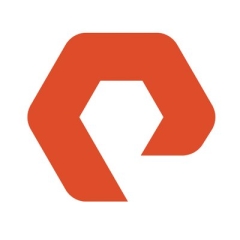What is our primary use case?
We are a system integrator and this is one of the solutions that we provide for our clients.
For our most recent customer, this solution is being used to host VMware workloads in an on-premises deployment.
How has it helped my organization?
Our customer has been able to migrate some of their cloud services back on-premises, which is of benefit because they were having some performance issues in the cloud.
What is most valuable?
The most valuable feature of this solution is its simplicity.
It is easy to deploy and it's all-flash, so it's very fast.
What needs improvement?
As partners, we should have the option to download the software, rather than have to go back through Pure to obtain it.
What do I think about the stability of the solution?
This solution seems to be fairly reliable. I haven't had any issues personally, or outages or anything of that nature.
What do I think about the scalability of the solution?
The flash array scales up well, but it doesn't really scale-out. I think that's more where Pure's FlashBlade comes into play. You'd have to replace it with the next model up controller, in order to scale.
How are customer service and technical support?
I haven't had much to do with technical support. Typically, we'll deploy it for our customer and hand it over, and then they'll manage it from there.
Which solution did I use previously and why did I switch?
Prior to this solution, our customer used Dell EMC, but there were several problems. They were not happy with it because of the performance of the array, and also the complexities around engaging the support teams. Their solution had also reached end-of-life, so they had to move to a new platform anyway. Ultimately, they wanted to move to something simpler than their existing platform, so they moved to Pure.
How was the initial setup?
This initial setup and deployment are pretty straightforward.
For the setup, it is very simple to populate the information. We had a workbook that was provided by Pure to give to the customer to gather all of the details. That made the implementation very straightforward.
The one thing that was a little bit annoying was the fact that we still had to come back through Pure to get the software. A lot of our other partners, we can just download it ourselves, and as long as we've got the process, we can go and do it ourselves. But, in this scenario, we still had to come back through Pure to actually get the software.
What about the implementation team?
We implement this solution for our customers. We are a partner and we're certified to do deployments.
What was our ROI?
I think that our customer has seen ROI because their existing solution was getting into extended maintenance, so it was costing a lot of money for that service. Also, with less time spent managing that old array, they had more time to do other things.
Which other solutions did I evaluate?
In addition to this solution, our customer considered another Dell EMC option, as well as one by Hitachi. They chose this because of the simplicity, and the fact that it is all-flash meant that they didn't have to worry about performance.
What other advice do I have?
VMware benefits our IT organization because we are partners, so we deploy VMware services. It also helps our customers make their applications more readily available and reliable.
We are using the VMware plug-in for Pure. It's meant more rapid provisioning of volumes for VMware, and it gives the customer more visibility of the storage.
Both the ease of setup and the reliability of the array makes it quite simple to manage for the customer.
My advice to anybody who is researching this solution is to consider that things are changing a lot in the industry at the moment. So, obviously, looking for things that are going to take less time to manage, are easy to implement, and give a good return on investment are important success criteria.
I would rate this solution a nine out of ten.
Disclosure: My company has a business relationship with this vendor other than being a customer: Partner.












